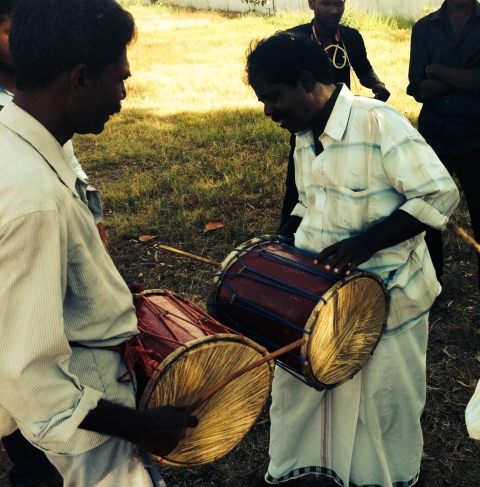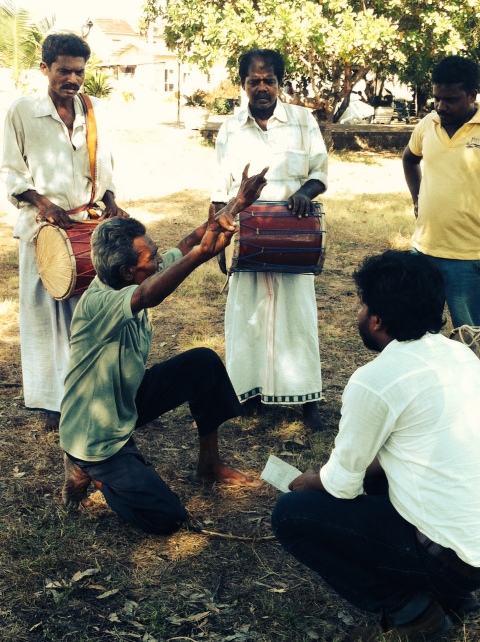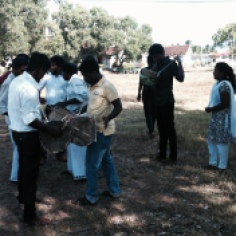Archive for the ‘ethnomusicology’ Tag
The Paraiyers’ drums

Another part of the Sri Lanka Norway Music Cooperation is the ‘village level performance’ program. Village-level performances give village elders that are custodians of rare and endangered folk forms (music, dance and theatre) support to put on a performance of their traditional work. Support can include funds to purchase instruments, for artist rehearsal time, to prepare costumes and props, and travel costs. This year, one of the village-level performances was in the Eastern province near the city of Batticaloa, and involved musician elders from four different villages.
The model that was used this year was particularly interesting. The musicians were all performers of the Parai drum tradition, which has for a long time been regarded as the instrument of the low-caste Paraiyers (see here for an interesting history of the Paraiyers). Because of this, members of the Paraiyer caste often reject this musical tradition, seeing the drum and its rhythms as markers of lowly status, and indeed, a marker of membership of that caste. Yet the musicians involved in this year’s village-level festival are adamant that the traditions and instruments should be preserved, and they have continued to play for rituals (usually funerals) despite the dismissive and often hostile responses from others in their community.

Therefore, building up the status and importance of the parai drum, and recognizing the work of the elder musicians in preserving it was one objective of the village-level festival. The next objective was to increase knowledge of the drum and its rhythms among young students of Tamil music. The Swami Vipulananda Institute of Aesthetic Studies (SVIAS) at Eastern University was a co-presenter of the village-level festival, and arranged for the elder-musicians to rehearse at the university each day in the weeks leading up to the performance. Students and lecturers of Tamil drum and dance worked with them closely, studying the artform. They worked outdoors, under big trees with a circle of benches surrounding the rehearsal space.
Bringing it into the University was a new initiative for the Music Cooperation, but it served two purposes – of helping to preserve and celebrate the knowledge of the elder musicians by training the next generation of performers, and of sidestepping the hostility towards the Parai drum within the musicians’ own communities.
I was able to observe two days of rehearsals during my research trip to Batticaloa two weeks ago, and these photos are from that visit. I saw a fascinating level of exchange taking place between the elders, the students, and the lecturers. Sometimes it was hard to see who was the authority, or the director of the project. One of the students explained it to me this way:
The elders are the experts in how to play this drum. They know all the rhythms and techniques and forms, and the students are eager to learn this from them. However, they have only performed for village rituals up until now, and they are not experienced in creating a performance for the public. So the students and the lecturers are contributing those ideas.
It reminded me that finding the balance between support and instruction, agency and collaboration, the authority of knowledge and the authority of institutions, and when to be expert and when to step back and give space for the content to emerge and evolve, is complex, messy, and somewhat infinite and imperfect pursuit. This project was tackling these challenges in what seemed to me to be courageous and thoughtful ways. I’m sure they all learned a great deal, and for me, it was an intriguing and thought-provoking process to observe.

Sounds of the soul
Regular readers will know that in 2010-2011 I spent four months as a visiting artist in East Timor, or Timor-Leste, as it is officially known. East Timor is a fascinating, compelling, challenging place to be – each of these in turn! I loved my time there and I learned much about myself as a musician, and about music in other cultures. East Timor’s traditional music is rich and multi-layered but at the time of my visit there were very few publications or recordings that I could access to familiarise myself with it. East Timor’s complex and often violent recent history of colonisation by Portugal (until 1974) and military occupation by Indonesia (1975-1999), has meant that its musical culture was at first undermined and later forbidden, seen as an expression of resistance and nationalism. It was therefore not well-documented in formal, Western ways, but of course knowledge was retained and transmitted aurally and orally.
Therefore, the recent publication of Lian Husi Klamar (Sounds of the Soul: The traditional music of East Timor), a book with accompanying CD/DVD, is extremely significant, as it is the first comprehensive published archive of this rich musical culture. The author, musician and researcher Ros Dunlop (a colleague and friend) spent years visiting Timor, travelling to remote and almost-inaccesible parts of the country to talk with elders, meet musicians and record their performances. One of the beautiful and particularly noteworthy things about this project is collaborative involvement of many Timorese musicians and artists. These people were acutely aware of the importance of creating an archive of their musical heritage. Younger Timorese – including artists from the Arte Moris art school in Dili – helped in all sorts of ways with the project, translating, driving and guiding, advising, filming and organising the recording sessions. The book has been published in both English and Tetun (the national language of East Timor), and will be highly valued in a country where there are few books published in their own language.
I’m proud to say that some of my photographs and interactions with traditional instruments have found their way into Ros’s book – Ros was determined to include as many examples as she could find. There are many national groups and family clans in East Timor who each have their own traditions, and Ros followed up every lead she could.
It was a huge project that spanned many years, and now the book and CD/DVD of the archive, Lian Husi Klamar (Sounds of the Soul: The traditional music of East Timor) is available for purchase (here). There’s a great interview with Ros Dunlop published here if you would like to know more about the project.
Towards the end of the book, Ros describes a children’s song in an ancient form of the Fataluku language (spoken in the town of Lospalos where I was based during my residency) which ends with the children sitting in a circle and pulling each other’s ears. I realised I had footage of some Lospalos children teaching an ear-pulling song to my partner Tony. This may or may not be the same song Tupukur Ulute that is described in the book, but it may well be related in some way. Their performance of the song in this little clip is a bit rowdy, a bit chaotic – definitely authentic!
Do children have their own unique musical language?
I’ve just come home from four inspiring days in Launceston at the ASME conference (ASME being the Australian Society For Music Education). Lots of highlights, lots of great conversations, and a great chance to catch up with colleagues in the academic world as well as all the Education Managers from the different orchestras around Australia and in New Zealand. I even found two Italian speakers to hang out with – my joy knew no bounds!
I will need to write about this in more detail, but will blog now about an idea that I am really intrigued by, and that came up in two separate unrelated research projects.
In one, Nick Reynolds (University of Melbourne) has been investigating the characteristics of children’s compositions in a music technology environment. A group of 7 primary school children composed hundreds (200, I think he said) of compositions of varying lengths, using waveform, midi and other recording software. These compositions were then analysed, and Nick also interviewed the children about their compositions, and reasons behind certain choices.
Learning songs from each other
I had a plan this term that, as part of a music project based on ‘Identity’, I would invite the children in each class to sing for us a song that they remember from their home country. We would learn to sing each others’ songs. The students would get a kick out of hearing the songs from their countries sung in their language by their peers. We could prepare instrumental arrangements for some, and make recordings and DVDs of the songs which we could then distribute to all the students at the end of the year, as a kind of ‘time capsule’ of their time at Language School – who they were, what they remembered, and who they shared this experience with.
Nice idea. It’s not the first time I’ve had it either. And not the first time I’ve planned to do it. However, I find it really tricky to make happen.
I find that:
- the students are often reluctant to sing. Sometimes this is a reluctance to sing on their own. Sometimes it’s a reluctance to sing, full-stop. Sometimes it is a reluctance to sing music from their other country (and there could be any number of reasons for this, that in the context I work in are not possible, nor appropriate to probe).
- if they do sing, it is often difficult to get a clear sense of it, clear enough to be able to teach it to others. Sometimes the melody, or even pitch contour, is unclear, and changes each time they sing it. Sometimes the rhythm is unclear. I suspect too, that I may be too solidly grounded in Western music to hear all the subtle rhythmic nuances in the music of other cultures.
- it is often slow work. What are the other students doing while I am trying to coax a song from an individual? This kind of task would perhaps be best done outside of lesson time, but like most music specialist teachers, I am fairly fully timetabled.
- the students don’t often seem that excited by this as a project idea. Of course there are exceptions to this, students who are delighted to teach you their songs. However, they are definitely in the minority. One of my research participants talked about how important it was for students at this school to be learning ‘Australian music’. Perhaps that is what the students want to be doing. They want to learn new stuff, and look to the future.
But what a missed opportunity! Perhaps it is unrealistic to do this in the context of music teaching. Perhaps it is better done as an outside researcher or music-collector, coming in specifically for that purpose, and just gathering one or two songs at a time. However, in that context, they wouldn’t have the trust and familiarity that the students have with me.
Then again, maybe I’m too familiar. And maybe the content of my lessons – instruments, instruments, instruments, and composing – is too familiar, because the students really enjoy doing music in this hands-on way. Maybe an outsider, with a specific song-collecting project, would be able to enjoy a different rapport with the students, and therefore get a different response.
A friend of mine did a project like that, working with parents as well as students in three or four different primary schools. He created a lovely song book at the end of the project. He is more skilled and experienced than I am in transcribing songs from African and Asian cultures. DF, if you are reading this, do you have any comments to add about your experiences, or in response to the above issues?
 Comments (2)
Comments (2)


